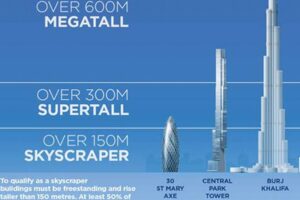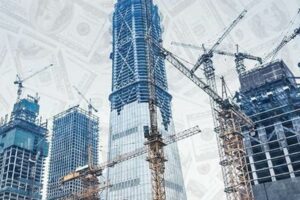Defining the term “skyscraper” can be a challenge due to varying perspectives influenced by factors such as architectural design, cultural norms, and regional differences. However, a widely accepted definition considers a building a skyscraper if it stands at or above 150 meters (492 feet) in height. Buildings that meet this height criterion are often designed with multiple stories, advanced structural systems, and cutting-edge technologies to withstand the challenges posed by high winds and seismic activity.
Skyscrapers have revolutionized modern architecture and urban planning by enabling efficient land utilization, accommodating large populations within limited urban areas. They offer panoramic views, natural light, and energy-efficient designs, making them sustainable and desirable living and working spaces. Historically, skyscrapers have been associated with economic prosperity and technological advancements, and their presence in a city’s skyline often signifies its economic strength and global stature.
The construction of skyscrapers involves collaboration among architects, engineers, urban planners, and real estate developers. It requires meticulous planning, innovative engineering solutions, and adherence to stringent safety regulations. As cities continue to grow and densify, skyscrapers are expected to play an increasingly important role in meeting the demands for sustainable and livable urban environments.
1. Height
Height is a primary factor in determining whether a building is considered a skyscraper. The Council on Tall Buildings and Urban Habitat (CTBUH), the leading authority on tall buildings, defines a skyscraper as a building that stands at or above 150 meters (492 feet) in height. This height criterion has been widely adopted by architects, engineers, and urban planners around the world.
There are several reasons why height is such an important factor in defining a skyscraper. First, height is a measure of a building’s structural complexity and engineering prowess. Constructing a building that is hundreds of meters tall requires innovative engineering solutions to ensure the stability and safety of the structure. Second, height is a symbol of economic power and prestige. Skyscrapers are often built in major cities as a way to showcase a city’s economic and global stature. Third, height can have a significant impact on a building’s function and design. Taller buildings can accommodate more people and offer more amenities, and they can also be designed to be more energy-efficient and sustainable.
Here are some real-life examples of how height is used to define skyscrapers:
- The Burj Khalifa in Dubai is the tallest building in the world, standing at 828 meters (2,717 feet) tall.
- The Shanghai Tower in China is the second tallest building in the world, standing at 632 meters (2,073 feet) tall.
- The One World Trade Center in New York City is the tallest building in the United States, standing at 541 meters (1,776 feet) tall.
Understanding the connection between height and skyscrapers is important for several reasons. First, it helps us to appreciate the engineering and architectural challenges involved in constructing these towering structures. Second, it helps us to understand the economic and cultural significance of skyscrapers. Third, it helps us to make informed decisions about how to use and regulate skyscrapers in our cities.
2. Stories
The number of stories in a building is another important factor in determining whether it is considered a skyscraper. A skyscraper typically has dozens or even hundreds of stories, stacked vertically to accommodate a large number of occupants and functions. The height of each story can vary, but they are typically around 3 to 4 meters (10 to 13 feet) tall.
There are several reasons why the number of stories is important in defining a skyscraper. First, the number of stories is a measure of a building’s capacity. A building with more stories can accommodate more people and offer more amenities. Second, the number of stories is a factor in a building’s structural design. A building with more stories requires a more robust structural system to support the weight of the upper stories. Third, the number of stories can affect a building’s energy efficiency and sustainability. A building with more stories can be designed to be more energy-efficient by using natural ventilation and daylighting.
Here are some real-life examples of how the number of stories is used to define skyscrapers:
- The Burj Khalifa in Dubai has 163 stories.
- The Shanghai Tower in China has 128 stories.
- The One World Trade Center in New York City has 110 stories.
Understanding the connection between stories and skyscrapers is important for several reasons. First, it helps us to appreciate the engineering and architectural challenges involved in constructing these towering structures. Second, it helps us to understand the economic and cultural significance of skyscrapers. Third, it helps us to make informed decisions about how to use and regulate skyscrapers in our cities.
3. Structure
The structural design of a building is a critical factor in determining whether it can be considered a skyscraper. Skyscrapers are typically constructed using a steel frame or reinforced concrete, which provides the strength and stability necessary to support the weight of the building and withstand high winds and seismic activity. The structural design of a skyscraper must also account for the building’s height and the loads that will be placed on it by occupants, equipment, and environmental factors.
One of the most important aspects of a skyscraper’s structural design is the foundation. The foundation must be strong enough to support the weight of the building and keep it from sinking into the ground. Skyscrapers are often built on bedrock or on piles driven deep into the ground. The foundation is also designed to resist lateral forces, such as those caused by earthquakes and wind.
The structural design of a skyscraper must also account for the building’s height. As a building gets taller, the wind forces acting on it increase. The structural design must be able to withstand these forces without the building swaying excessively. Skyscrapers are often designed with a tapered shape to reduce the wind forces acting on them.
The structural design of a skyscraper is a complex and challenging task. However, it is essential to ensure the safety and stability of these towering structures.
4. Function
The function of a building is a key factor in determining whether it can be considered a skyscraper. Skyscrapers are typically designed for a specific purpose, such as residential, commercial, or mixed-use. The function of the building will influence its design, height, and location.
- Residential skyscrapers are designed to provide housing for people. They are typically located in urban areas where land is scarce and the demand for housing is high. Residential skyscrapers can vary in height and design, but they typically have a large number of stories and offer a variety of amenities, such as swimming pools, fitness centers, and retail stores.
- Commercial skyscrapers are designed for business use. They are typically located in central business districts and house offices, retail stores, and other commercial enterprises. Commercial skyscrapers are often designed to be tall and impressive, and they may feature a variety of architectural styles.
- Mixed-use skyscrapers combine residential and commercial uses. They are typically located in urban areas where there is a demand for both types of space. Mixed-use skyscrapers can vary in height and design, but they typically offer a variety of amenities and services to their occupants.
The function of a building is an important factor to consider when determining whether it is a skyscraper. Skyscrapers are typically designed for a specific purpose, and their function will influence their design, height, and location.
5. Location
Location plays a significant role in determining whether a building can be considered a skyscraper. Skyscrapers are typically located in urban areas, where land is scarce and the demand for space is high. The location of a skyscraper can influence its height, design, and function.
- Central Business Districts (CBDs)
CBDs are the commercial and financial centers of cities, and they are often home to the tallest skyscrapers. Skyscrapers in CBDs are typically designed to accommodate large numbers of office workers and businesses. They are often built to be tall and impressive, and they may feature a variety of architectural styles.
- Waterfronts
Waterfronts are another popular location for skyscrapers. Skyscrapers on waterfronts can offer stunning views of the water and the city skyline. They are often designed to be mixed-use developments, with residential, commercial, and retail space. Skyscrapers on waterfronts can also be designed to be environmentally sustainable, with features such as green roofs and solar panels.
- Transportation Hubs
Skyscrapers are often located near transportation hubs, such as airports and train stations. This makes them convenient for commuters and travelers. Skyscrapers near transportation hubs can also be designed to be mixed-use developments, with residential, commercial, and retail space. This can create a vibrant and lively urban environment.
- Suburban Areas
In recent years, there has been a trend towards building skyscrapers in suburban areas. This is often done to create a more urban environment in suburban areas, and to attract businesses and residents. Skyscrapers in suburban areas are often designed to be mixed-use developments, with residential, commercial, and retail space. They may also be designed to be environmentally sustainable, with features such as green roofs and solar panels.
The location of a skyscraper is an important factor to consider when determining whether it can be considered a skyscraper. Skyscrapers are typically located in urban areas, where land is scarce and the demand for space is high. The location of a skyscraper can influence its height, design, and function.
6. Design
The design of a building is a critical factor in determining whether it can be considered a skyscraper. Skyscrapers are typically designed with a steel frame or reinforced concrete structure, which provides the strength and stability necessary to support the weight of the building and withstand high winds and seismic activity. The structural design of a skyscraper must also account for the building’s height and the loads that will be placed on it by occupants, equipment, and environmental factors.
In addition to the structural design, the architectural design of a skyscraper also plays a role in determining whether it is considered a skyscraper. Skyscrapers are often designed with a distinctive and iconic appearance, which can make them landmarks in the cities in which they are built. The architectural design of a skyscraper can also be influenced by the building’s function and location.
For example, the Burj Khalifa in Dubai is the tallest building in the world, and its design was inspired by the traditional Islamic architecture of the region. The Shanghai Tower in China is another example of a skyscraper with a unique and iconic design. The tower’s design was inspired by the shape of a traditional Chinese pagoda.
The design of a skyscraper is an important factor to consider when determining whether it is a skyscraper. Skyscrapers are typically designed with a steel frame or reinforced concrete structure, and they often have a distinctive and iconic appearance. The design of a skyscraper can also be influenced by the building’s function and location.
7. Purpose
The purpose of a building is a key factor in determining whether it can be considered a skyscraper. Skyscrapers are typically designed for a specific purpose, such as residential, commercial, or mixed-use. The purpose of the building will influence a range of factors, including its height, design, and location.
- Residential skyscrapers are designed to provide housing for people. They are typically located in urban areas where land is scarce and the demand for housing is high. Residential skyscrapers can vary in height and design, but they typically have a large number of stories and offer a variety of amenities, such as swimming pools, fitness centers, and retail stores.
- Commercial skyscrapers are designed for business use. They are typically located in central business districts and house offices, retail stores, and other commercial enterprises. Commercial skyscrapers are often designed to be tall and impressive, and they may feature a variety of architectural styles.
- Mixed-use skyscrapers combine residential and commercial uses. They are typically located in urban areas where there is a demand for both types of space. Mixed-use skyscrapers can vary in height and design, but they typically offer a variety of amenities and services to their occupants.
The purpose of a building is an important factor to consider when determining whether it is a skyscraper. Skyscrapers are typically designed for a specific purpose, and their purpose will influence their design, height, and location.
8. Impact
Skyscrapers have a significant impact on the urban landscape and the lives of city dwellers. They can reshape skylines, create new neighborhoods, and stimulate economic growth. However, the construction of skyscrapers also raises concerns about environmental sustainability, urban planning, and social equity. Balancing the benefits and challenges associated with skyscrapers is crucial for sustainable urban development.
- Economic Impact
Skyscrapers can be a major economic driver for cities. They can attract businesses, create jobs, and generate tax revenue. For example, the construction of the Burj Khalifa in Dubai created thousands of jobs and helped to boost the city’s economy. Skyscrapers can also increase property values in the surrounding area, making them a valuable asset for investors.
- Environmental Impact
Skyscrapers can have a significant environmental impact. The construction and operation of skyscrapers can consume large amounts of energy and resources. They can also contribute to air pollution and greenhouse gas emissions. However, skyscrapers can also be designed to be energy-efficient and environmentally sustainable. For example, the One World Trade Center in New York City is LEED-certified and uses a variety of sustainable features, such as a rainwater collection system and a green roof.
- Social Impact
Skyscrapers can have a positive or negative social impact on cities. On the one hand, skyscrapers can provide affordable housing for people who live and work in the city. They can also create new public spaces and amenities, such as parks and plazas. On the other hand, skyscrapers can also lead to gentrification and displacement of low-income residents. They can also create wind tunnels and other environmental hazards for pedestrians.
- Cultural Impact
Skyscrapers can be iconic landmarks that define a city’s skyline and identity. They can also be a source of pride for city residents. For example, the Empire State Building in New York City is one of the most recognizable buildings in the world and is a popular tourist destination. Skyscrapers can also be used to express a city’s values and aspirations. For example, the Petronas Towers in Kuala Lumpur, Malaysia, are designed to resemble two hands reaching towards the sky, symbolizing the country’s progress and development.
The impact of skyscrapers on cities is complex and multifaceted. It is important to consider both the benefits and challenges associated with skyscrapers in order to make informed decisions about their construction and use.
FAQs on “When is a Building Considered a Skyscraper?”
This section provides answers to commonly asked questions surrounding the topic of skyscrapers, their defining characteristics, and their impact on the urban landscape.
Question 1: What is the primary factor in determining whether a building qualifies as a skyscraper?
Answer: Height is the primary factor, with buildings standing at or above 150 meters (492 feet) generally considered skyscrapers. This criterion may vary slightly based on regional contexts.
Question 2: Besides height, what other factors contribute to a building’s classification as a skyscraper?
Answer: Additional factors include the number of stories, structural design, function, location, and architectural style. Skyscrapers often have numerous stories, robust structural systems, and are designed for specific purposes such as residential, commercial, or mixed-use.
Question 3: Where are skyscrapers typically located, and why?
Answer: Skyscrapers are predominantly found in urban areas where land is scarce and the demand for vertical space is high. They contribute to efficient land utilization and accommodate large populations within limited urban boundaries.
Question 4: What are some of the benefits of constructing skyscrapers?
Answer: Skyscrapers offer advantages such as panoramic views, natural light, and energy-efficient designs. They promote sustainable living and working environments, and their presence in a city’s skyline often reflects economic strength and global stature.
Question 5: Are there any negative impacts associated with skyscrapers?
Answer: While skyscrapers provide numerous benefits, they also raise concerns about environmental sustainability, urban planning, and social equity. Their construction can consume significant resources and contribute to environmental challenges. Additionally, the influx of high-rise buildings can impact urban planning and potentially lead to issues like gentrification and displacement.
Question 6: How can we ensure the sustainable development of skyscrapers?
Answer: Sustainable skyscraper development requires a balanced approach that considers environmental, economic, and social factors. Employing eco-friendly materials, implementing energy-saving technologies, and promoting mixed-use developments are crucial for creating sustainable and livable urban environments.
Summary: Skyscrapers are architectural marvels that have transformed modern cities, offering numerous benefits while presenting challenges. Understanding the defining characteristics, advantages, and potential impacts of skyscrapers is essential for informed decision-making and sustainable urban planning.
Transition: This concludes our exploration of “When is a Building Considered a Skyscraper?” Delving deeper into the topic will provide a comprehensive understanding of these iconic structures and their role in shaping urban environments.
Tips for Understanding “When is a Building Considered a Skyscraper?”
Grasping the concept of “skyscraper” involves considering various factors. Here are some tips to enhance your understanding:
Tip 1: Focus on Height
Height is the primary determinant of a skyscraper’s classification. Buildings exceeding 150 meters (492 feet) are generally considered skyscrapers. This criterion may vary slightly depending on regional contexts.
Tip 2: Consider Other Factors
While height is crucial, other factors contribute to a building’s skyscraper status. These include the number of stories, structural design, function, location, and architectural style.
Tip 3: Understand the Purpose
Skyscrapers are typically designed for specific purposes, such as residential, commercial, or mixed-use. Understanding the intended use helps clarify a building’s classification.
Tip 4: Examine the Location
Skyscrapers are predominantly found in urban areas due to limited land availability and high demand for vertical space. Their presence can reshape skylines and create new neighborhoods.
Tip 5: Explore the Impact
Skyscrapers have significant impacts on cities, including economic growth, environmental concerns, and social dynamics. Considering these effects is essential for informed decision-making.
Tip 6: Seek Professional Insights
Consult reputable sources, such as architects, engineers, and urban planners, to gain expert perspectives on skyscraper design, construction, and societal implications.
Tip 7: Visit Skyscraper Observatories
Visiting observation decks in skyscrapers provides firsthand experience of their height and panoramic views. This can deepen your understanding and appreciation for these architectural marvels.
Summary:
By following these tips, you can develop a comprehensive understanding of the factors that determine whether a building qualifies as a skyscraper. This knowledge will enable you to engage in informed discussions and appreciate the significance of skyscrapers in shaping our urban landscapes.
When is a Building Considered a Skyscraper
In conclusion, determining whether a building qualifies as a skyscraper involves a multifaceted analysis encompassing height, structural design, function, location, and architectural style. Height serves as the primary criterion, with buildings exceeding 150 meters (492 feet) generally recognized as skyscrapers. However, other factors contribute to this classification, underscoring the complexity and diversity of these architectural marvels.
Skyscrapers have profoundly transformed modern cities, redefining skylines, accommodating large populations, and serving as symbols of economic prosperity and technological advancement. Their presence has spurred urban development, created new neighborhoods, and provided innovative solutions to the challenges of urbanization.
Understanding the concept of “when is a building considered a skyscraper” empowers individuals to engage in informed discussions, appreciate the significance of these structures, and make informed decisions about their construction and integration into urban environments. As cities continue to grow and evolve, skyscrapers will undoubtedly play a pivotal role in shaping our future landscapes and addressing the challenges of sustainable and livable urban development.







